Many thanks to SWLing Post contributor, The Professor, who shares the following guest post:
A 1960s Signal Sniffer
by The Professor
I just recently purchased a radio that on eBay that looks very intriguing, especially if you happen to DX AM Radio. It’s a mid-60s portable made in Japan – a Nova Tech Pilot II . However, wasn’t just a grab ën go to the beach kind of transistor set. This radio has a serious side. It’s actually an RDF – a “radio direction finder.”
I have seen these kinds of radios before, somewhere. Only the ones I’ve noticed were older and had more of a military look. Although I’ve never actually attended a hamfest, I’m sure these types of receivers might be found at a gathering like that.
But this is a smaller and frankly more stylish version of RDF. Not to go into too much detail about something I know little about, but before GPS became ubiquitous, devices like this would commonly assist in the navigation of ships and aircraft by pinpointing “beacon” transmitters at specific known locations.
As you might imagine, this type of technology was (and probably still is) a strategic tool for military purposes. In fact, one of more “infamous” incidents of using radio direction finders was when they were utilized by the Japanese in the bombing of Pearl Harbor. Their bombers just honed in on the signal of a Honolulu AM station (KGU at 760kHz) as their beacon.
So, this radio has three bands which were traditionally used by beacon transmitters. Besides the medium wave band, it also has a section of the longwave spectrum, and the VHF airband. Other models included the old marine band (around 3 to 5MHz). A later model also included the CB frequencies, and another included a VHF police band (called the Nova Tech Action!!).
So, no shortwave on this one. No FM either, but I have plenty of radios with those bands (like almost all of them). Of course, there’s not much to find on this side of the world on longwave these days, and listening to aircraft communications has its fans but it’s not something I’ve done much. But this thing has a unique toolset for medium wave DXing. And after doing a little research online I’ve discovered that the big rotating double ferrite on top is only one of the attributes it offers for AM DXing purposes.
For one, it has an RF amplifier in the front end to help pull those weak signals up out of the noise floor. For another, it has a pure RF gain function called “DF” (direction finder), which when turned on shuts down the AGC (automatic gain control) and allows you to tweak the RF gain any way you like. And it also has a very accurate tuning meter. That all sounds good to me.
So, I haven’t actually seen my Nova Tech in the flesh yet, and it will be probably a couple of weeks before I get a chance to give it a test drive. But I’m pretty confident in my purchase at this point. More than a few people have spoken glowingly of the AM DXing capabilities of this set. But one of the reasons I decided to go ahead and bid on this device was that not only did the dealer have an excellent eBay rating, but he says he also fully serviced the radio electronically and physically restored most of its original beauty. Apparently, it was cleaned up, recapped, and even a transistor was replaced. And he also aligned the AM band IF and re-peaked the antenna trim for AM and the airband.
Although this radio is still a twinkle in my eye at this point, I thought I’d mention it here in hopes some of the fine readers of this blog might have something to say about DXing with direction finding radios. And I was especially hoping that a few people might have personal experience with these 60s era Nova Tech receivers. I also noticed online that there are U.K. versions of these RDFs that were branded as “Bendix” radios.
All insights offered as comments are appreciated, and once I spend some time with this radio I’ll be sure to offer some of my own.
I always find it so much fun to await the arrival of an interesting old radio I’ve purchased on eBay, especially one that I’d never heard of before.
Thanks for sharing your find, Professor! I was not at all familiar with the Nova Tech Pilot II. I love the Transoceanicesque design! No doubt, it’ll be a handsome addition to your collection, and I’m willing to bet a MW DX machine as well!

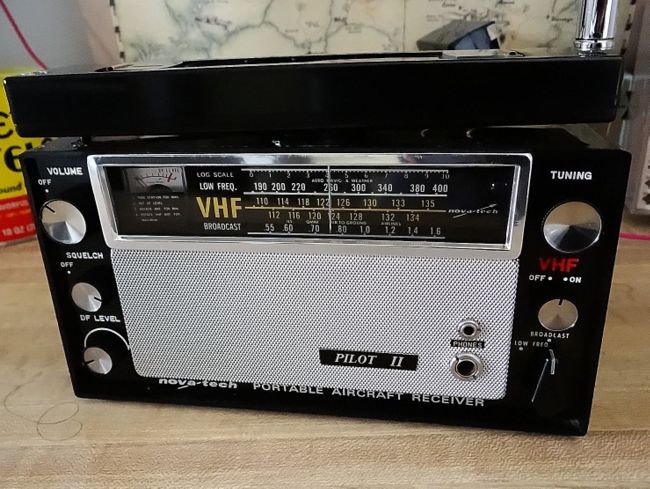
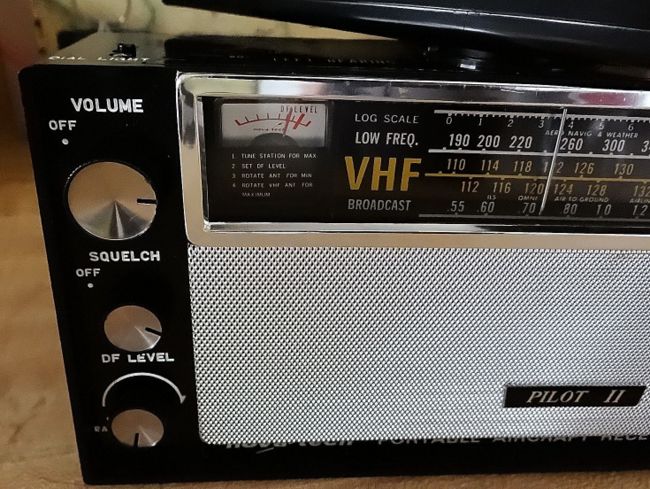
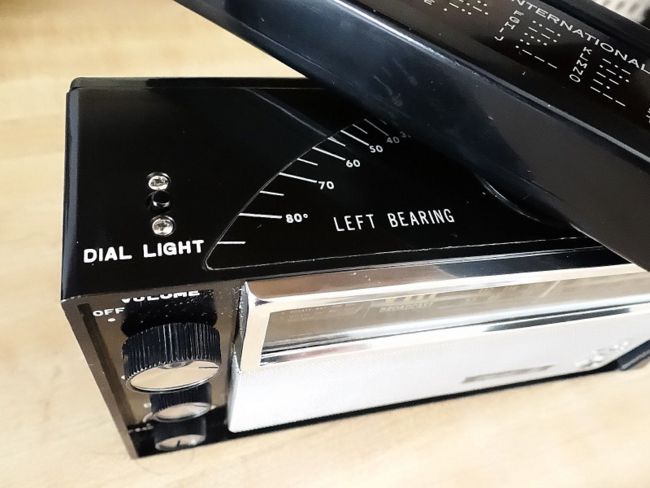
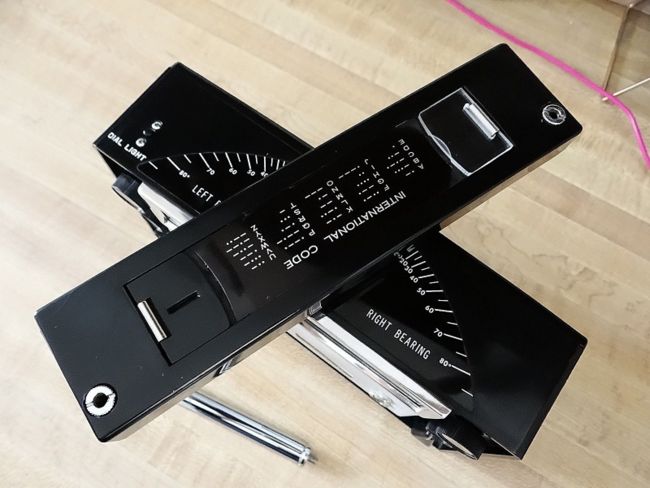
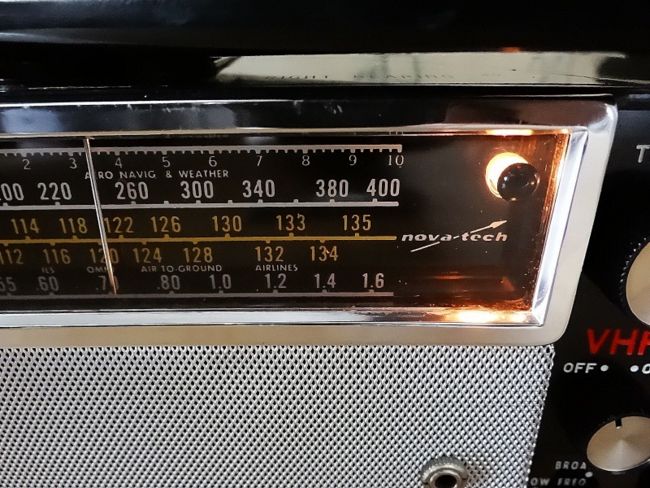
Had one in the 70’s. Still have but needs major refurb and it got me started for professional comms qualification. You will not be disappointed and would like one now for old time’s sake.
GOT ONE! I got mine from an old man that worked for Goodyear and built 2 blimps with them. He told me they used them to communicate with the ground for directional instructions. Mine still has the original leather case with an antenna pouch, but unfortunately the antenna is missing. And it’s missing the power cord. (looks like a standard 12v plug) Have you opened yours up? I opened mine and it is in like new condition inside. GREAT radio.
I just found a pilot ll from my dads estate are you interested in it Professor ?
A friend’s father had a similar portable, complete with rotating loop, in 1970, but I never noticed the brand. I remember hearing some beacons on the low frequency band, exotic when I was already interested in radio, but just barely. But at the time, multiband portables were kind of all over the place. Not just Radio Shack, but the lunch counter near my house, where I bought candy and comic books, they had some on display. The Panasonic RF-1600 I got for five dollars at a garage sale a few years ago is from the same era. Though it shows only one band at a time, so when I noticed it, I thought it was just a very heavy am/fm portable. So it’s a slick receiver, but lacking the big dial that identified these multiband portable of the seventies.
Some years back I came upon a stray issue of Elementary Electronics at a garage sale. Complete with a Radio Shack ad on the back cover. That was common, but this was for the Astronaut 7, one if the company’s largest multiband portable in the early seventies. I suddenly had the urge to find one, for nostalgia sake. That’s when I started finding shortwave radios at garage sales, maybe I just started noticing them. I found some good digitally tuned portables, but also an RCA am/fm with a low shortwave band, and a Radio Shack portable that tuned to about 20MHz, probably like that Astronaut 7 but without the public service bands. The Panasonic was the most recent. I saw an Astronaut 7 at a garage sale, but since they were listening to it, I assumed it wasn’t for sale.
Michael
Larry and Mario, thanks for your comments. You both get what made this radio intriguing to me at first glance when eBay tempted me with it. And I do plan to say something about its performance and personality here once I’ve had a chance to mess around with it in person. If most of what I’ve read is true, I should have some fun with this thing. I’ll let you know.
Professor, your radio is more than that, it’s a work of art; hobbyist’s eye candy hi hi. I’ll bet that in old boating magazines you’ll find ads for them. A few different models of this radio were manufactured.
I had a Ray-Jefferson RDF that was loads of fun on the AM band with it’s large rotatable ferrite antenna.
Thank you for sharing your experience and enjoy the radio.
They are original. But I’ll bet they’re mono. That’s why I have a mono mini-plug adapter to use with older model radios, so I can hear them with both ears using stereo headphones
Are those audio jacks original or just user modifications? they look a little out of place to put them in the grille.
I mean a radio with bearing marks? How can one resist?
Prof: I hope you follow up with a review of this unique radio. Funny you should mention hamfests because I go to lots of them and see DFRs there but have never jumped on one. Think I will next time. I need a radio with bearing marks! I’m pretty much an AM BC guy so I’dd love to hear your thoughts. Hoping audio is good too. Thanks.
Had one of these radios in 1967. I loved the set and used it to monitor air band transmissions and for AM/Longwave DXing. Great sensitivity and good selectivity. Unfortunately, it fell off a shelf and broke into several pieces. Tried to restore it, but never did…
Miss it….!!
That’s good to hear James. Speaking of the radio falling over, that radio did (or could) come with a nice stand that attached with large screws on each side of it. If any readers have that part for some reason, from a broken radio or something, I’d probably be willing to pay a little to have you send it to me. And if you have the two intact whip antennas that screw into the rotating unit I’d be interested in those as well. Just thought I’d throw that out there.
My parents had exactly the same radio but it was dark chocolate brown. They used it on their boat for basic navigation. The one thing I remember most about that radio is the fact we found we could listen to the Vancouver Police up the top end of the VHF band. Some nights the police calls were better than anything on TV. 🙂